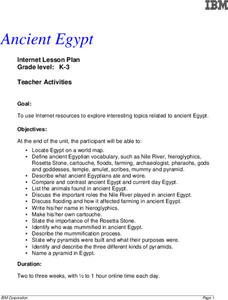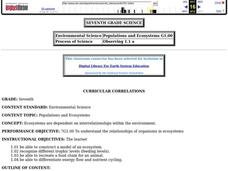Curated OER
Animal Tracks - Walking and Running
Learners, using paper and water, make tracks and record the time needed to make them. They compare tracks made walking and running to determine the speed of the animal.
Curated OER
Scavenger Hunt! Exploring the Prairie
Learners participate in an online scavenger hunt activity, researching the type of housing pioneers built to match the natural environment. They design and create a poster exhibit or Web page presenting information about pioneer housing.
Curated OER
Living in a Community
Students practice their reading comprehension skills by reading articles about living in a community. They answer questions related to the material to test for comprehension.
Curated OER
Japanese Carp Kites/Children's Day
Students listen to the story "A Carp for Kimiko" and discuss its lesson and theme. They design and create their own carp kite in celebration of Children's Day. They discuss gender discrimination and how that makes them feel.
Curated OER
Ancient Egypt
Students use the internet to research topics on Ancient Egypt. They practice using new vocabulary and identify the types of food they ate and clothing they wore. They explain the role of the Nile as well.
Curated OER
Populations and Ecosystems
Seventh graders create a model of an ecosystem and label it to show structure and function. They research the food web of an aquatic animal and also trace energy flow from the primary producer up the food chain.
Curated OER
How Are the Eyes of Different Organisms Adapted for Sight?
Learners compare/contrast the human eye to two other organisms. They use micro viewers to identify the human eye structures, complete a Venn diagram worksheet, identify the function of each eye structure, and answer discussion questions.
Curated OER
My Family and Me: Our Similarities and Differences
Young scholars are introduced to basic genetic information to discover how they acquired the traits they have. Individually, they develop a family tree and identify the similarities and differences between two poeple. In groups, they...
Curated OER
Investigating Ocean Life
Sixth graders explore the various forms of ocean life. They research a creature that lives in the ocean. Students use their research information to create a series of HyperStudio stacks about their sea creature.
Curated OER
Stream Watch
Students discuss why it is important to take care of streams, what is non-point source and point source pollution, what are some causes of pollution in streams, and what can we do to prevent some of these causes of pollution? They steam...
Curated OER
Climbing the Pyramid
Students examine the Food Pyramid to discover the foods they need to eat to have a healthy body. Using food brought to class, they must place the food in the correct category in the pyramid. In groups, they test food samples for fat...
Curated OER
Look At Those Leaves!
Pupils observe, measure, and sort tree leaves. They examine leaves individually, in groups, and in relationship to the entire tree. Pupils take a walk outside for a "Leaf Walk." Students are each given a lunch size paper bag, so that...
Curated OER
Mary, Mary, Quite Contrary
First graders use simple vegetable cut out and colored paper flower peddles to make simple patterns. They start out with a simple 2-element patterns around the theme of a daisy and increase in difficulty.
Curated OER
Extinction Is Forever
Students observe models of two kinds of forests with low and high biodiversity. They observe and record the effects of habitat destruction or extinction rates. They also conduct research about mass extinction like that of the ancient...
Curated OER
Around the World
Students explore ways people from around the world are like them. They discuss how geography affects the way people live and work and how culture affects a person's day to day life. Students give a presentation over a chosen country to...
Curated OER
"Fall"owing Changes in the Season
Students create a whole class A-B-"C"eason Book. Each student is responsible for creating a "letter" page relating to changes, adaptations, or other fall concepts. After hard copies of the class ABC books are created, the teachers using...
Curated OER
Fish Parasite Survey
Students count nematodes, cestodes and crustaceans on approximately one-hundred and fifty fish. They fill out autopsy reports for external and internal parasites then complete and discuss guide questions to make inferences about parasite...
Curated OER
Fish Parasite Survey
Students survey and dissect as many fish as possible. They count nematodes, cestodes and crustaceans on the fish, fill out autopsy reports, and transfer data to a chalkboard data table. Students graph the results of the entire class...
Curated OER
What Beautiful Caterpillars!
Second graders investigate the life cycle of the caterpillar. They create a caterpillar habitat and care for it. Students make daily observations that are recorded in a writing journal. During the process of observation the students...
Curated OER
California Biodiversity
Students examine several maps of California exhibiting features such as precipitation, topography, and vegetation. They look for patterns that might be the source of or influence biodiversity in different regions. They pay particular...
Curated OER
Antarctica
Students explore why Antarctica is so important to the planet. They investigate the physical characteristics. Students create their own unique treaty of governance for Antarctica and discuss how laws are enforced in Antarctica.
Curated OER
Save the _____ Story Board
Young scholars research an endangered species. They examine statistics, characteristics, and information about the species. Students play "webmaster" and design a site that will help to save an endangered species.
Curated OER
The Seven Characteristics of Life
Third graders investigate the characteristics of living and nonliving things. They conduct a research quest in order to identify the seven characteristics of life. Then students pick one aspect and use it to create a song meant to be...
Curated OER
Heat Misconceptions
Third graders determine that gloves do not provide heat, but rather, they insulate or hold in any heat that is in their hand. They discuss the different temperatures found in ecosystems around the world. What do animals that live in...

























